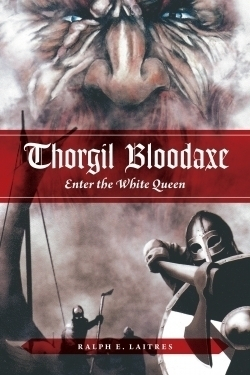Thorgil Bloodaxe
Enter the White Queen
Strongly influenced by Robert E. Howard’s fictional hero Conan the Barbarian, the exploits of red-headed Norse warrior Thorgil Bloodaxe will delight old-school sword-and-sorcery enthusiasts. Ralph E. Laitres’ novel, Thorgil Bloodaxe: Enter the White Queen, is unfettered by the sociopolitical or economic undertones that seem prevalent in today’s fantasy fiction. Thorgil Bloodaxe is an über-masculine character who occupies a testosterone-driven universe straight out of pulp-fiction-era publications, such as the Tarzan series by Edgar Rice Burroughs and the Doc Savage series co-authored by Henry L. Ralston, John Nanovic and Lester Dent. Laitres’ works also echo fantasy science-fiction of the latter twentieth century, like John Norman’s Gor series and Robert Adams’ Horseclans series.
Upon his mighty steed named Frost-Mane, Thorgil Ragnarrsson the Bloodaxe wields his war axe. With his large but nimble body, indomitable will, and capacity for periodic rages that increase his Herculean-like strength, Thorgil is an uncompromising and unforgettable character. His honor and his pragmatic sense of good and evil are dictated by a world of blood, guts, bile, magic, and cold steel. The author writes, “There were few that could match the Bloodaxe’s ferocity and bravery in battle. It was a certain guarantee Thorgil was to be found at the forefront of battle, gore-splattered with the crumpled heaps of bodies of the opposing piled high around him.”
The novel opens with Thorgil’s discovery that Hvit, the malevolent White Queen, is seeking revenge against him for killing her evil twin sister. Hvit sends an army of her most skilled assassins to capture Thorgil. He proves to be a more elusive and powerful opponent than the White Queen anticipates, though, especially when aided by a beautiful enchantress.
Laitres’ language follows the style of Robert E. Howard, with its purple prose and brilliantly rendered guttural dialogue. In addition, we expect authors in the sword-and-sorcery subgenre to write passages filled with luscious metaphors and similes to describe their heroes, villains, and the worlds they inhabit. Because of incomplete editing, however, many of Laitres’ descriptions in Thorgil Bloodaxe are redundant and cliché, and his heavy-handed use of strong adjectives eventually makes them lose their intended effect.
Fortunately, such problems do not detract from the story. And the illustrations and maps contributed by Casper Zelenko—printed entirely in black and white—help lend the novel a pulp-like quality, similar to the black-and-white magazines published by Marvel Comics. Like Howard’s Conan the Barbarian, Thorgil the Bloodaxe has the potential to become an iconic character in pop culture.
Reviewed by
Lee Gooden
Disclosure: This article is not an endorsement, but a review. The publisher of this book provided free copies of the book and paid a small fee to have their book reviewed by a professional reviewer. Foreword Reviews and Clarion Reviews make no guarantee that the publisher will receive a positive review. Foreword Magazine, Inc. is disclosing this in accordance with the Federal Trade Commission’s 16 CFR, Part 255.

